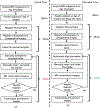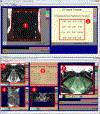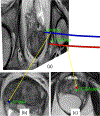System Integration and Preliminary Clinical Evaluation of a Robotic System for MRI-Guided Transperineal Prostate Biopsy
- PMID: 31485544
- PMCID: PMC6726403
- DOI: 10.1142/S2424905X19500016
System Integration and Preliminary Clinical Evaluation of a Robotic System for MRI-Guided Transperineal Prostate Biopsy
Abstract
This paper presents the development, preclinical evaluation, and preliminary clinical study of a robotic system for targeted transperineal prostate biopsy under direct interventional magnetic resonance imaging (MRI) guidance. The clinically integrated robotic system is developed based on a modular design approach, comprised of surgical navigation application, robot control software, MRI robot controller hardware, and robotic needle placement manipulator. The system provides enabling technologies for MRI-guided procedures. It can be easily transported and setup for supporting the clinical workflow of interventional procedures, and the system is readily extensible and reconfigurable to other clinical applications. Preclinical evaluation of the system is performed with phantom studies in a 3 Tesla MRI scanner, rehearsing the proposed clinical workflow, and demonstrating an in-plane targeting error of 1.5mm. The robotic system has been approved by the institutional review board (IRB) for clinical trials. A preliminary clinical study is conducted with the patient consent, demonstrating the targeting errors at two biopsy target sites to be 4.0mm and 3.7mm, which is sufficient to target a clinically significant tumor foci. First-in-human trials to evaluate the system's effectiveness and accuracy for MR image-guide prostate biopsy are underway.
Keywords: MRI-compatible robotic system; MRI-guided prostate biopsy; image-guided surgery; piezoelectric actuation.
Figures










Similar articles
-
Piezoelectrically Actuated Robotic System for MRI-Guided Prostate Percutaneous Therapy.IEEE ASME Trans Mechatron. 2015 Aug;20(4):1920-1932. doi: 10.1109/TMECH.2014.2359413. IEEE ASME Trans Mechatron. 2015. PMID: 26412962 Free PMC article.
-
Development and Evaluation of an Actuated MRI-Compatible Robotic System for MRI-Guided Prostate Intervention.IEEE ASME Trans Mechatron. 2012 Sep 12;18(1):273-284. doi: 10.1109/TMECH.2011.2163523. Epub 2011 Oct 17. IEEE ASME Trans Mechatron. 2012. PMID: 23326181 Free PMC article.
-
Body-mounted robotic assistant for MRI-guided low back pain injection.Int J Comput Assist Radiol Surg. 2020 Feb;15(2):321-331. doi: 10.1007/s11548-019-02080-3. Epub 2019 Oct 17. Int J Comput Assist Radiol Surg. 2020. PMID: 31625021 Free PMC article.
-
Targeted prostate biopsy and MR-guided therapy for prostate cancer.Abdom Radiol (NY). 2016 May;41(5):877-88. doi: 10.1007/s00261-016-0681-3. Abdom Radiol (NY). 2016. PMID: 26907717 Free PMC article. Review.
-
Advancements in magnetic resonance-guided robotic interventions in the prostate.Top Magn Reson Imaging. 2008 Dec;19(6):297-304. doi: 10.1097/RMR.0b013e3181aa68b8. Top Magn Reson Imaging. 2008. PMID: 19512852 Free PMC article. Review.
Cited by
-
In Vivo Feasibility Study: Evaluating Autonomous Data-Driven Robotic Needle Trajectory Correction in MRI-Guided Transperineal Procedures.IEEE Robot Autom Lett. 2024 Oct;9(10):8975-8982. doi: 10.1109/lra.2024.3455940. Epub 2024 Sep 6. IEEE Robot Autom Lett. 2024. PMID: 39371576
-
Body-Mounted Robotics for Interventional MRI Procedures.IEEE Trans Med Robot Bionics. 2020 Nov;2(4):557-560. doi: 10.1109/tmrb.2020.3030532. Epub 2020 Oct 13. IEEE Trans Med Robot Bionics. 2020. PMID: 33778433 Free PMC article.
-
Evaluation of robot-assisted MRI-guided prostate biopsy: needle path analysis during clinical trials.Phys Med Biol. 2018 Oct 16;63(20):20NT02. doi: 10.1088/1361-6560/aae214. Phys Med Biol. 2018. PMID: 30226214 Free PMC article.
-
A System for Real-Time, Online Mixed-Reality Visualization of Cardiac Magnetic Resonance Images.J Imaging. 2021 Dec 14;7(12):274. doi: 10.3390/jimaging7120274. J Imaging. 2021. PMID: 34940741 Free PMC article.
-
Data-driven adaptive needle insertion assist for transperineal prostate interventions.Phys Med Biol. 2023 May 15;68(10):10.1088/1361-6560/accefa. doi: 10.1088/1361-6560/accefa. Phys Med Biol. 2023. PMID: 37080237 Free PMC article.
References
-
- Hricak H, Choyke PL, Eberhardt SC, Leibel SA and Scardino PT, Imaging prostate cancer: A multidisciplinary perspective 1, Radiology 243(1) (2007) 28–53. - PubMed
-
- Kadoury S, Yan P, Xu S, Glossop N, Choyke P, Turkbey B, Pinto P, Wood BJ and Kruecker J, Realtime trus/mri fusion targeted-biopsy for prostate cancer: a clinical demonstration of increased positive biopsy rates, International Workshop on Prostate Cancer Imaging, Springer; (2010), pp. 52–62.
Grants and funding
LinkOut - more resources
Full Text Sources
Other Literature Sources
